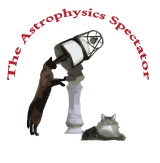
The basic layout of the site is as survey paths, which can be found under the Surveys link at the top of this and most other pages on this site. Each survey begins with a basic overview of the subject. Part of this overview include simulators of astrophysical phenomena that allow the reader to experiment with the phenomena. The later pages in a survey present the subject in greater and more mathematical depth. A path ends with research pages that describe current research projects and results in astrophysics.
The links at the top of each page are Home, which is the current home page of this site, Commentary, which is an index of short essays on topics loosely related to astrophysics, Surveys, which is the index of survey paths, Research, which is the index of research pages and the page leading to recent news items, Background, which is the index page for all background information on astrophysics, including survey pages, simulator pages, tables, bibliographic references, and lists of web resources, Previously, which is an index of previous home pages, and Site Info, which describes the site and its author, and gives contact information.
On the home page is found an addition link. This is the Store link, which leads to reviews of worthwhile books on astronomy and other relates subjects. Links on these pages enable the reader to buy these books from Amazon.com, which helps to financially sustain this web site.
Each Wednesday, a new issue of The Astrophysics Spectator is published that comprises a new home page, a new commentary, whatever news the author notices, and background, research, and simulator pages added to the survey paths. The home page acts as an index to the newly added pages. This site also has an RSS channel, whose link is given at the bottom of the right-hand column of this page.
July 6, 2005
With the coming of a hot and lazy summer, I have slowed by pace of writing. This week I add a single page to this web site, another page for the “X-ray Astronomy” survey path. It discusses the x-ray emission from the coronas of stars.
Our deepest understanding of stellar coronas comes from the study of the Sun. The solar corona is a very hot and tenuous wind that blows away from the Sun. This wind has a temperature above 1 million degrees Kelvin, which is far above the Sun's effective temperature of 5800Copyright � K. With its high temperature, the corona is an x-ray source. Nearby stars reveal their coronas to us through the x-rays they emit.
Stellar coronas are created in stars the size of the Sun and smaller, because these stars have dynamic atmospheres. If the gas in a star like the Sun were stable, so that energy flowed from the star's interior by the diffusion of radiation, the temperature of the star would only decrease with altitude above the photosphere. But stars like the Sun are convective, so their outer layers are continually boiling, rapidly carrying energy from the interior to the photosphere. This convective motion is an engine that generates magnetic fields. At times we see these magnetic fields in the the familiar solar prominences, the cool loops of matter arching over the photosphere of the Sun. These magnetic fields are also responsible for transporting and dissipating energy into the solar corona, heating the tenuous corona to temperatures rivaling the interior of the Sun.
Because the generation of magnetic fields is driven by the convective transport of energy out of a star's interior, the power converted into magnetic fields and transported to the corona is out of physical necessity always much smaller than the power radiated from the star's photosphere; the x-ray luminosity of a star is typically less than 1% of its optical luminosity. But this low luminosity is sufficient to enable the coronas of stars other than the Sun to be observed with current x-ray observatories. The primary information contained in the x-rays seen from these stars is of the temperatures and compositions of the coronas.
Jim Brainerd
Background
Stellar Coronas as X-ray Sources. Stars the mass of the Sun and less are surrounded by an extremely hot and tenuous x-ray emitting atmosphere. This atmosphere, which is a wind flowing away from the star with a characteristic temperature between 106Copyright �K and 107Copyright �K, is produces by convectively-created magnetic fields at the photosphere of the star. Most of our understanding of corona comes from the study of the Sun's corona, but current x-ray observatories are able to observe the x-rays from the coronas of nearby stars. (continue)

RSS Channel
